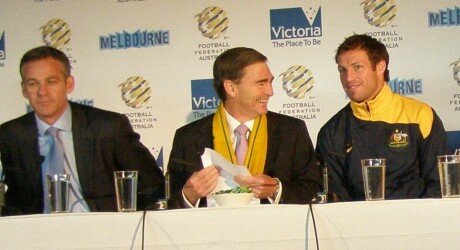Time for FFA to keep its nerve
Roy Hay
(This aritcle appeared on the SBS website, The World Game on 22 February 2012 and in Goal Weekly on 24 February 2012.)
The eruption of the ebullient Clive Palmer, multi-millionaire natural resources baron and owner of Gold Coast United, as self-appointed spokesman for the owners of the A-League clubs has Football Federation Australia (FFA) on the back foot. He wants more say for the owners who are bankrolling the league, though their total contribution is probably less than that contributed by the public, through their purchase of tickets, merchandise, sponsors’ products and above all, tax concessions and direct subsidies by Federal, State and local governments.
It must gall the owners that one of Australia’s richest men, Frank Lowy, presides over the FFA and the A-League but is apparently unwilling to dip into his own pocket to support the league. But if Lowy did so the media would be jumping on his back straight away, as they did at the start of the league, with cries of ‘conflict of interest’. He and his family helped a number of clubs financially to meet the stringent financial conditions for entry laid down. Subsequently they assisted the ownership transitions which occurred in others. Most of this was done by stealth to avoid a public outcry. In doing so Lowy was repeating something he had once done as the leader of the Hakoah club in the ‘bad old days’ of the Australian Soccer Federation (ASF). He put his house up as a guarantee for the funding of the club, and then realised the idiocy of that approach. From then on he was determined that football must run as a business and be self-sustaining, not dependent on one-off donations by benefactors.
The dilemma remains, what is the best strategy for the A-League to become a self-sustaining entity? Several people, including David Crawford, the Professional Footballers Association, Wilson Smith and some of the current owners have argued for the A-League to become a separate entity from the FFA, or at the very least for the owners to have a greater influence over its operation. These are arguable cases, but the historical record and the example of other sporting operations in Australia are not favourable.
The Victorian Football League used to be run by its clubs, until Sir Kenneth Luke built Waverley Park to break their control and that of the ground managers who administered the venues at which the game was played. Eventually the AFL, as it became, set up a commission to run the game and over time this took the kind of control it now has today under Andrew Demetriou and his board. And they have done reasonably well, thank you, despite recent complaints about losses and Demetriou’s remuneration. There are major differences, of course. The AFL does not have to run an expensive international game in senior, junior, male and female competitions as FFA has to do. The success of the Socceroos sometimes cross-subsidises the domestic league.
Most people have blamed ethnic politics for the problems of soccer under the old ASF, but in fact the main factor was the governing structure set up at the foundation of that body in 1961. As a paper at the time said, it was government of the clubs, by the clubs, for the clubs. That might have been fine had the game continued in the same way as it had done since the 1880s, but within a decade the game had gone national and international, with the ultimately successful attempt to qualify for the World Cup in 1974. The success could not be repeated and the key reason was that the clubs through the state federations controlled the ASF, the tail was wagging the dog.
Given the current requirements of the game as a whole, returning to club control for the A-League would be a recipe for disaster. The current structure is not perfect, but changes should be very carefully thought through and above all the FFA must not pander to those critics in the media who cannot distinguish between income and wealth, or who want to treat these fundamental issues about the health of the game as items for public amusement by pillorying the current members of the FFA executive.
Roy Hay is a member of the History Panel of the FFA and is working on a history of the game in Australia with Bill Murray. These are his personal views.







Marnie Haig-Muir: Your review of the latest Rankin is right on the money, Roy. This book...